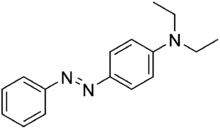 | |
| Names | |
|---|---|
| Other names
Solvent yellow 56 C.I. 11021 | |
| Identifiers | |
3D model (JSmol) |
|
| ChEBI | |
| ChemSpider | |
| ECHA InfoCard | 100.017.834 |
PubChem CID |
|
| UNII | |
CompTox Dashboard (EPA) |
|
| |
| |
| Properties | |
| C16H19N3 | |
| Molar mass | 253.349 g·mol−1 |
| Melting point | 168 °C (334 °F; 441 K) |
Except where otherwise noted, data are given for materials in their standard state (at 25 °C [77 °F], 100 kPa).
Infobox references | |
Solvent Yellow 56 is the organic compound N,N-diethyl-p-(phenylazo)aniline. It is an azo dye, which has the appearance of a reddish yellow powder. Its EINECS number is 219-616-8.[1] Its structure is similar to Solvent Yellow 124, which used as a fuel dye in European Union, and to Aniline Yellow.
Uses
It is used to dye hydrocarbon solvents, oils, fats, waxes (candles), notably petrol, mineral oil and shoe polishes, and polystyrene resins. In pyrotechnics, it is used in some yellow colored smokes, reflecting its tendency to sublime.[1]
References
- 1 2 Hunger, Klaus; Mischke, Peter; Rieper, Wolfgang; Raue, Roderich; Kunde, Klaus; Engel, Aloys (2005). "Azo Dyes". Ullmann's Encyclopedia of Industrial Chemistry. Weinheim: Wiley-VCH. doi:10.1002/14356007.a03_245. ISBN 978-3527306732.
This article is issued from Wikipedia. The text is licensed under Creative Commons - Attribution - Sharealike. Additional terms may apply for the media files.